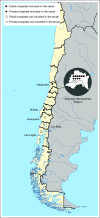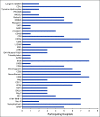Evaluation of the Pediatric Neuro-Oncology Resources Available in Chile
- PMID: 33788596
- PMCID: PMC8081533
- DOI: 10.1200/GO.20.00430
Evaluation of the Pediatric Neuro-Oncology Resources Available in Chile
Abstract
Purpose: Pediatric neuro-oncology resources are mostly unknown in Chile. We report the human and material resources available in Chilean hospitals providing pediatric neuro-oncology services.
Methods: A cross-sectional survey was distributed to 17 hospitals providing pediatric neuro-oncology services (Programa Infantil Nacional de Drogas Antineoplásicas [PINDA] hospitals, 11; private, 6).
Results: Response rate was 71% (PINDA, 8; private, 4). Pediatric neuro-oncology services were mainly provided within general hospitals (67%). Registries for pediatric CNS tumors and chemotherapy-related toxicities were available in 100% and 67% of hospitals, respectively. CNS tumors were treated by pediatric oncologists in 92% of hospitals; none were formally trained in neuro-oncology. The most used treatment protocols were the national PINDA protocols. All WHO essential medicines for childhood cancer were available in more than 80% of the hospitals except for gemcitabine, oxaliplatin, paclitaxel, and procarbazine. The median number of pediatric neurosurgeons per hospital was two (range, 2-6). General neuroradiologists were available in 83% of the centers. Pathology specimens were sent to neuropathologists (58%), adult pathologists (25%), and pediatric pathologists (17%). Intensity-modulated radiotherapy, conformal radiotherapy, and cobalt radiotherapy were used by 67%, 58%, and 42% of hospitals, respectively. Only one private hospital performed autologous hematopoietic cell transplant for children with CNS tumors.
Conclusion: A wide range of up-to-date treatment modalities are available for children with CNS tumors. Our survey highlights future directions to improve the pediatric neuro-oncology services available in Chile such as the expansion of multidisciplinary clinics, palliative care services, long-term cancer survivorship programs, dedicated clinical research support teams, establishing standardized mechanism for sending pathologic specimen for second opinion to international specialized centers, and establishing specialized neuro-oncology training program.
Conflict of interest statement
The following represents disclosure information provided by authors of this manuscript. All relationships are considered compensated unless otherwise noted. Relationships are self-held unless noted. I = Immediate Family Member, Inst = My Institution. Relationships may not relate to the subject matter of this manuscript. For more information about ASCO's conflict of interest policy, please refer to
Open Payments is a public database containing information reported by companies about payments made to US-licensed physicians (
No potential conflicts of interest were reported.
Figures






References
-
- World Health Organization : Chile Profile. https://www.who.int/countries/chl/en/
-
- Chilean Ministerio de Salud. Vigilancia Epidemiologica de Cancer : Registro Nacional de Cáncer Infantil (RENCI) Quinquenio 2007-2011. http://www.ipsuss.cl/ipsuss/site/artic/20180117/asocfile/20180117150429/...
-
- Chan MH, Boop F, Qaddoumi I: Challenges and opportunities to advance pediatric neuro-oncology care in the developing world. Childs Nerv Syst 31:1227-1237, 2015 - PubMed
MeSH terms
LinkOut - more resources
Full Text Sources
Other Literature Sources

